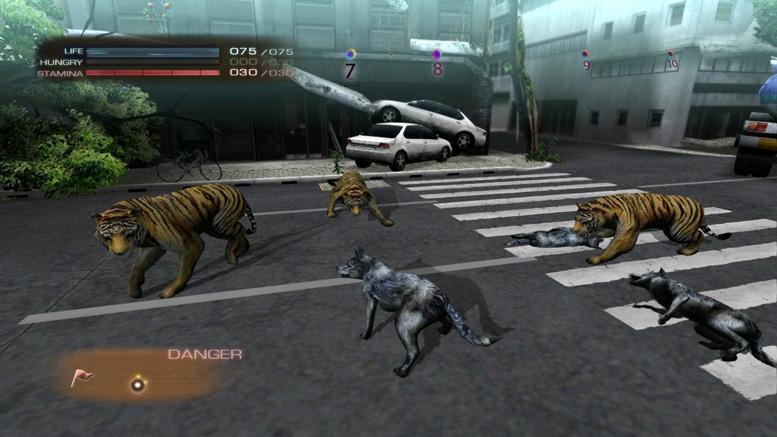Tokyo Jungle is a PS3 game that was digitally released on Sony’s Playstation Network in September 2012. The game was developed by Sony Computer Entertainment’s Japan Studio, the first party studio responsible for commercial successes such as Loco Roco, Patapon, and Ape Escape. While perhaps not on par with these other highly acclaimed games, Tokyo Jungle still brings an entertaining and fresh experience to the table.
Tokyo Jungle is a game that takes place in a mysterious future where humans have just completely vanished and all of the animals of the world are left in the decaying remains of human society. Without humans there to feed and take care of them, domesticated animals have turned feral and now hunt other animals for food as their base instincts would lead them to do. You play as a wide variety of said animals, from Pomeranians, to deer, to even bears. The actual reason behind the vanishing of the humans would be spoiler as the game does reveal or at least hint toward it through small text logs found in survival mode.
Tokyo Jungle starts off with two types of gameplay mode, Survival and Story, however, Story mode is locked from the start giving you the only option to go to Survival mode. The games takes you to a tutorial of very basic gameplay elements, just sort of your run of the mill “sneak past predators,” “press this button to attack,” “when your animal gets too old, mate and you can play as their children.” It pretty much just brushes over the absolute bare bones of this game. I like this because the tutorial doesn’t overstay its welcome and once you know the basics it just drops you into this world and expects you to learn just from basic trial and error. The tutorial tells you nothing certain cautionary gameplay elements such as toxic areas that are most likely covered in radiation that slowly kill your animal, or fleas which prevent you from moving as quickly as you previously could and can be caught by other members of your species. The game also tells you nothing of how to unlock other playable animals or sections of story mode. Again, this is something that could be found out through sheer exploration.
The way the game only lets you know the basics and then drops you into this cruel world, it really does feel like a survival game, you aren’t very good at it at first, but as you keep playing you learn the quirks of how the game runs and you eventually have it down to a science and know exactly what to do and not to do in order to succeed. This is a very old school attempt at game design, a theme of pure exploration and trial and error like in the old Nintendo Entertainment System days. This may come across as a bit frustrating to modern gamers and at first was frustrating to me as well, but once I realized what the game was going for I changed my point of view and quickly found myself deeply engaged in this game. I played it for hours on end just trying to get further than my last playthrough, making each time I started a new game last longer than the previous attempt. I quickly found myself almost addicted to this game, which is a great sign; however it isn’t without its flaws.
For one, the few times that the game tries to teach you something with expository in-game text, its often the same exact things you learned in the mandatory tutorial, making me wonder why exactly it needs to be repeated if it’s impossible to play the game without the tutorial first.
Second, saving your game is incredibly inconvenient, it can only be done at a nest after you’ve taken over an area, however if you use the nest to mate it can no longer be used to save, meaning you’ll have to wait until you reach the next one to have the opportunity to save. Also, saving doesn’t just save your game and pop you right back in, it saves, then loads for a while, then takes you to the main menu, which incredibly inconvenient for anyone who wanted to save and keep playing as you’ll have to wait for it to load the game all over again, and there is no way to turn this off.
Third, jumping can be kind of a hassle, the game works fine on the 3 dimensional plane, but when it requires you to do a bit of platforming, you can tell the developers didn’t really put much effort into making that feel very fluid for you. Jumping on platforms can feel clanky and imprecise, which is the exact opposite of what you want in a came that requires you to move very fast from one enemy to the next in order to get a meal so that you can keep living.
Fourth, the framerate: this isn’t an issue that you face very often in the game; however, I went to an area a little later than the game wanted me to go and the enemies multiplied during that wasted time, they multiplied so much that I could hardly tell where I was on the screen, and the game couldn’t handle that many objects at one time so it went so slow that I had to just let myself lose because I had no chance at all of being able to continue the game. As I said this only happened once and it was because I showed up late to an area that the game told me to go to, however they really should place a limit on how many enemies can occupy an area because that was just overkill to the point where I blame it on bad game design. My final gripe with this game is that in-game objectives can’t be done out of order. What I mean by this is that if Objective #1 is to defeat two enemies and Objective #2 is to capture a certain territory, if you capture the territory before you defeat 2 enemies, then Objective #2 will not be complete, even after you defeat 2 enemies, if the territory is already captured by you, it won’t count until you capture it again, which could take a lot of in-game years. This is an issue because if you want to unlock things, then at least the first 6 basic objectives you ALWAYS have to play the way the game wants you to play and no other way, which is incredibly annoying in a game that inspires exploration and trial-and-error.
If you can get past these issues like I did, then I do recommend Tokyo Jungle, it isn’t necessarily at the top of my list, but I do think underneath all the issues is a pretty good game and it really does shine through if you give it enough of a chance. Tokyo Jungle is available now on Sony’s Playstation Network service for $14.99.




